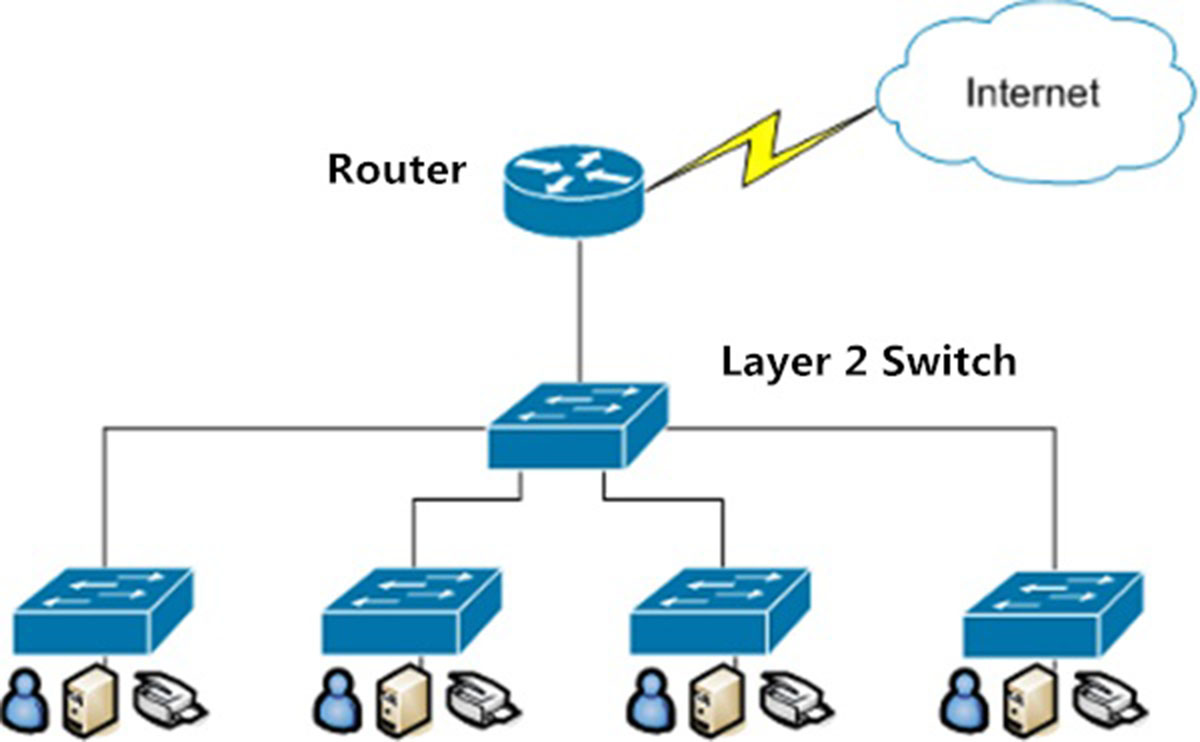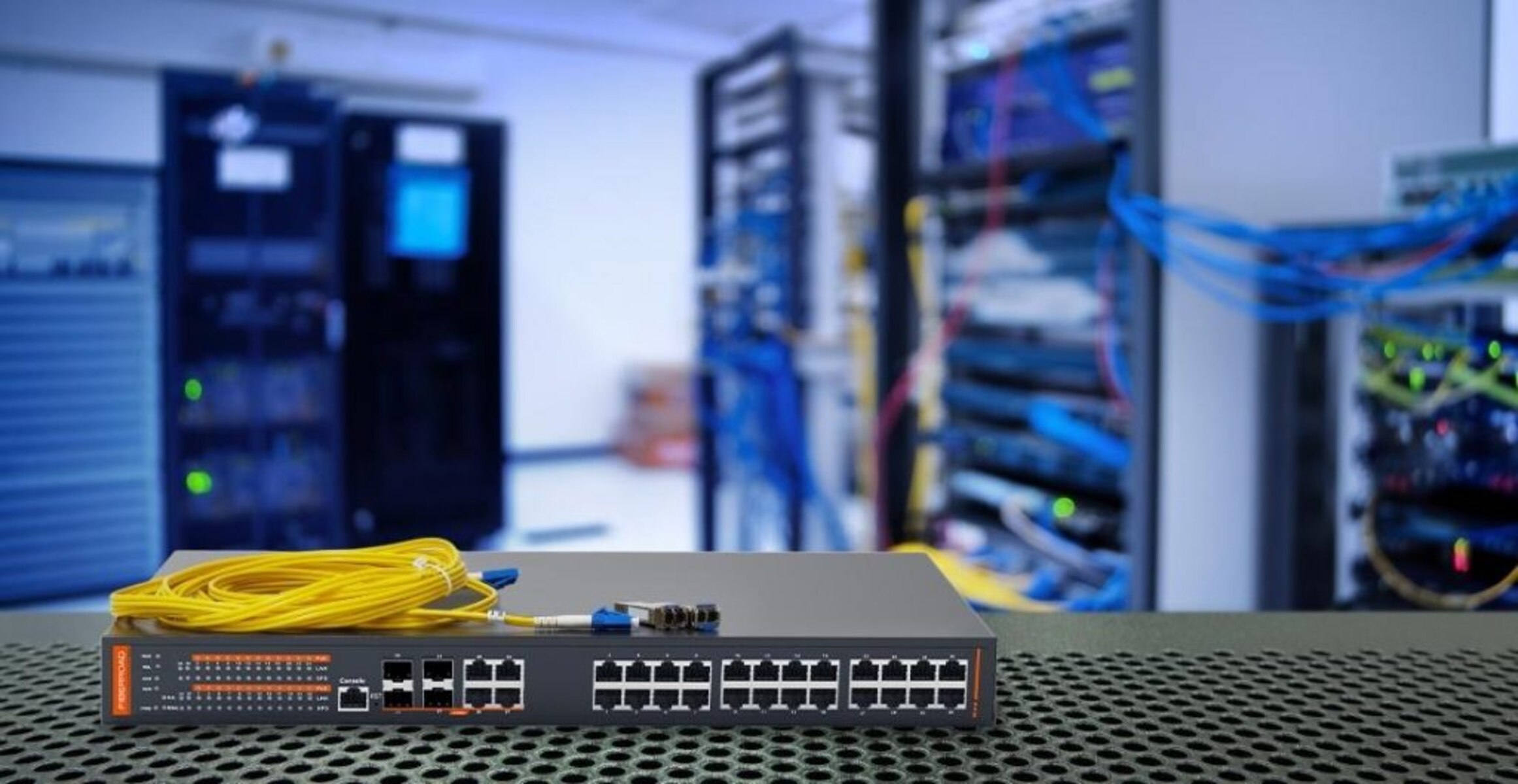Introduction
Welcome to the world of networking, where devices such as routers, switches, and IP addresses play a crucial role in connecting, communicating, and managing data between computers. When it comes to networking, Layer 2 switches are an essential component that allows for efficient data transmission within a local area network (LAN).
Layer 2 switches, also known as Ethernet switches, are designed to operate at the data link layer of the OSI model. Their primary function is to receive, process, and forward Ethernet frames to the appropriate destination. Unlike routers, which operate at the network layer and use IP addresses for routing, Layer 2 switches primarily rely on MAC addresses to direct traffic.
However, you might wonder, if Layer 2 switches don’t use IP addresses, why would they need one? In this article, we will delve into the importance of IP addresses for Layer 2 switches and why assigning them can bring numerous benefits to your network infrastructure.
So, buckle up and let’s dive into the world of Layer 2 switches and IP addresses!
Understanding Layer 2 Switches
Before we explore the significance of IP addresses for Layer 2 switches, it is essential to have a clear understanding of what Layer 2 switches are and how they function in a network environment.
A Layer 2 switch is a networking device that operates at the data link layer (Layer 2) of the OSI model. Its primary role is to facilitate communication between devices within a local area network (LAN) by forwarding Ethernet frames based on their MAC addresses.
Unlike routers, which can connect multiple networks and make decisions based on IP addresses, Layer 2 switches are typically used to create and manage LANs. They provide a fast and efficient way of transferring data between devices connected to the same network.
Layer 2 switches use a method called MAC learning to build a MAC address table or a forwarding database. When a switch receives a frame, it examines the source MAC address and associates it with the port from which the frame was received. This process allows the switch to learn the MAC addresses of connected devices and create a mapping between MAC addresses and corresponding ports.
Once the switch has built its MAC address table, it can forward frames more efficiently. When a frame with a destination MAC address is received, the switch consults its MAC address table to determine the appropriate output port and forwards the frame only to that specific port. This process eliminates unnecessary broadcast traffic and improves network performance.
Layer 2 switches also support features such as VLANs (Virtual LANs) and Spanning Tree Protocol (STP), which enhance network segmentation, redundancy, and fault tolerance.
In summary, Layer 2 switches are fundamental building blocks of local area networks. They provide a means of connecting multiple devices within a LAN, facilitating the efficient transfer of data based on MAC addresses.
What is an IP Address?
An IP address, short for Internet Protocol address, is a unique numeric identifier assigned to each device connected to a network. It serves as a way to identify and locate devices in a networked environment. Just like how our homes have addresses for mail delivery, IP addresses allow data to be sent and received between devices on the internet.
IP addresses are composed of a series of four numbers separated by periods, such as 192.168.0.1. Each number can range from 0 to 255, providing a vast pool of possible addresses. There are two main types of IP addresses: IPv4 and IPv6. IPv4, the most widely used version, consists of 32 bits and supports approximately 4.3 billion unique addresses. On the other hand, IPv6 is the next-generation IP addressing protocol, utilizing 128 bits and capable of accommodating an enormous number of addresses.
An IP address can be assigned dynamically or statically. Dynamic IP addressing involves the assignment of temporary addresses to devices using protocols like DHCP (Dynamic Host Configuration Protocol). This method is commonly used in home networks and allows for easy configuration and management of IP addresses. Static IP addressing, on the other hand, assigns a fixed IP address to a device, ensuring that it retains the same address every time it connects to the network. This approach is often used for servers, printers, and other devices that require permanent and reliable network access.
Each IP address consists of two parts: the network portion and the host portion. The network portion identifies the network to which the device is connected, while the host portion distinguishes individual devices within that network. This division allows for efficient routing of data across networks and plays a crucial role in network communication.
With the understanding of what an IP address is and its basic components, let’s now explore its significance in networking and why it is relevant to Layer 2 switches.
The Role of IP Address in Networking
The IP address plays a vital role in networking by providing a unique identifier to each device connected to a network. It serves as a crucial component in facilitating communication, routing data, and ensuring efficient network operation.
One of the primary roles of an IP address is to enable devices to communicate with each other over a network. When a device wants to send data to another device, it needs to know the IP address of the intended recipient. The source device encapsulates the data into IP packets and includes the destination IP address in the packet header. This addressing information is used by routers and Layer 3 devices to route the packets across different networks until they reach the destination device.
IP addresses also play a significant role in network routing. Routers, which operate at the network layer of the OSI model, rely on IP addresses to determine the best path for data transmission. By analyzing the destination IP address of a packet, routers can reference their routing tables and make decisions on how to forward the packets towards their final destination. This process ensures that data is efficiently routed across multiple networks and reaches the intended recipient.
Additionally, IP addresses are essential for network security and access control. Many network security measures, such as firewalls and access control lists (ACLs), are based on IP addresses. By specifying which IP addresses are allowed or denied access to certain resources or services, network administrators can ensure that only authorized devices and users can access sensitive information or resources.
Furthermore, IP addresses are used in network management and troubleshooting. When devices have IP addresses assigned, network administrators can remotely monitor and manage them. They can use tools like Simple Network Management Protocol (SNMP) to collect information about the status and performance of network devices. This ability to remotely manage and troubleshoot devices simplifies network administration and reduces the need for physical access to each device.
In summary, IP addresses play a critical role in networking by providing unique identification to devices, facilitating communication, enabling efficient network routing, supporting security measures, and simplifying network management and troubleshooting.
Benefits of Assigning an IP Address to Layer 2 Switches
Layer 2 switches are traditionally known for operating based on MAC addresses rather than IP addresses. However, assigning an IP address to a Layer 2 switch can bring several valuable benefits to your network infrastructure. Let’s explore some of these advantages:
Remote Management and Troubleshooting: Assigning an IP address to a Layer 2 switch allows network administrators to remotely manage and troubleshoot the device. Using protocols like SSH (Secure Shell) or Telnet, administrators can access the switch’s command-line interface (CLI) from anywhere on the network. This remote access enables efficient configuration, monitoring, and troubleshooting tasks without the need for physical presence near the switch.
Inter-VLAN Communication: VLANs (Virtual LANs) are commonly used to segment networks and improve security and performance. By assigning an IP address to a Layer 2 switch, the switch can act as a gateway for inter-VLAN communication. It can route traffic between different VLANs, allowing devices on separate VLANs to communicate with each other. This capability enhances network flexibility and facilitates efficient data exchange between different parts of the network.
Network Monitoring and Traffic Analysis: Layer 2 switches with IP addresses can be monitored and analyzed using network monitoring tools. By connecting the switch to a network management system, administrators can collect valuable information about the switch’s performance, traffic patterns, and connected devices. This data can be used for troubleshooting, capacity planning, and identifying potential network bottlenecks.
Hierarchical Management and Scalability: When multiple Layer 2 switches are deployed in a network, assigning IP addresses to these switches allows for hierarchical management and scalability. By configuring the switches with unique IP addresses, administrators can easily identify and manage each switch individually. This hierarchical approach simplifies network management, improves network visibility, and facilitates the expansion of the network infrastructure.
Support for Layer 3 Features: Assigning an IP address to a Layer 2 switch opens up the possibility of enabling Layer 3 features on the switch. Layer 3 switches, also known as multilayer switches, combine the functions of Layer 2 switches and routers. With an IP address assigned, Layer 2 switches can be configured to perform routing functions, including inter-VLAN routing and static routing. This flexibility enhances network design options and allows for more efficient routing within the LAN.
By assigning an IP address to a Layer 2 switch, network administrators can unlock a range of benefits, including remote management and troubleshooting capabilities, improved inter-VLAN communication, enhanced network monitoring and traffic analysis, hierarchical management and scalability, and support for Layer 3 features. These advantages contribute to a more robust and flexible network infrastructure, enabling efficient network management and facilitating better overall network performance.
Remote Management and Troubleshooting
Assigning an IP address to a Layer 2 switch opens the door to remote management and troubleshooting capabilities, which can greatly enhance the efficiency and effectiveness of network administration. Let’s explore the benefits of remote management and troubleshooting for Layer 2 switches.
With an IP address assigned to a Layer 2 switch, network administrators gain the ability to remotely manage and configure the device. By using protocols such as SSH (Secure Shell) or Telnet, administrators can establish a secure command-line interface (CLI) connection to the switch from any location within the network. This remote access removes the need for physical proximity to the switch, enabling administrators to configure and manage the switch’s settings, monitor its performance, and update its firmware without being in the same physical space as the device.
Remote management allows for quicker and more efficient troubleshooting, as administrators can immediately access the switch’s CLI and diagnostic tools from their own workstation. They can remotely identify and resolve issues, conduct tests, and adjust settings without the need for on-site visits. This not only reduces response time but also minimizes the disruption of network operations.
Assigning an IP address to a Layer 2 switch also enables network administrators to use network management software to monitor and analyze the switch’s performance and traffic patterns. This data can help identify potential bottlenecks, analyze network behavior, and detect any abnormal or suspicious activities. Network monitoring tools can provide real-time alerts, allowing administrators to proactively address issues and optimize network performance.
Moreover, remote access to the switch’s CLI allows administrators to manage multiple switches efficiently. By centrally managing and configuring switches remotely, administrators can ensure consistent configurations and apply changes across multiple devices simultaneously. This centralized approach simplifies network administration, reduces the chances of human errors, and enhances overall network security.
In addition, remote management and troubleshooting enable network administrators to gather valuable information about the switch’s status, logs, and historical data. This knowledge can assist in troubleshooting efforts and facilitate the identification of recurring issues or patterns. It provides insights into the network’s behavior and performance, aiding in decision-making processes related to network upgrades, capacity planning, and future network expansion.
In summary, assigning an IP address to a Layer 2 switch enables remote management and troubleshooting capabilities. This allows administrators to configure, monitor, and troubleshoot the switch from a remote location, reducing response times, minimizing network disruptions, and enhancing network performance. These remote management features also simplify network administration, promote consistency, and provide valuable insights into network behavior and performance.
Inter-VLAN Communication
VLANs (Virtual LANs) are a popular networking concept used to segment a physical network into logical segments. Each VLAN establishes separate broadcast domains, enhancing security, performance, and manageability. However, without proper configuration, devices within different VLANs cannot communicate with each other. Assigning an IP address to a Layer 2 switch can facilitate inter-VLAN communication and overcome this limitation.
When an IP address is assigned to a Layer 2 switch, it can act as a gateway between VLANs, allowing devices in different VLANs to communicate with each other. The Layer 2 switch becomes a Layer 3 device, capable of routing traffic between VLANs and connecting different network segments.
By configuring IP addresses on the switch’s VLAN interfaces, network administrators define the gateways for each VLAN. When a device in one VLAN wants to communicate with a device in another VLAN, it sends the network traffic to the IP address of the switch’s VLAN interface associated with the source VLAN. The switch then examines the destination IP address and makes a routing decision, forwarding the traffic to the appropriate VLAN via the corresponding VLAN interface. This process enables seamless communication between devices in different VLANs.
Inter-VLAN communication is particularly useful in scenarios where devices in different VLANs need to exchange information. For example, in a corporate network, there may be separate VLANs for different departments or groups. Assigning an IP address to the Layer 2 switch enables employees in different VLANs to access shared resources, such as file servers or printers, located in other VLANs. It fosters collaboration and data accessibility across departments, enhancing productivity and efficiency.
In addition, inter-VLAN communication allows for centralized network services. By configuring the Layer 2 switch as the default gateway for each VLAN, network administrators can ensure that devices in different VLANs can access common services, including DHCP, DNS, or internet connectivity, provided by the switch or connected routers. This approach simplifies network management, reduces the need for duplicate services, and promotes efficient use of network resources.
Assigning an IP address to a Layer 2 switch for inter-VLAN communication also reduces the dependence on external routers. By utilizing the Layer 2 switch as the VLAN gateway, organizations can optimize network architecture and reduce the cost associated with deploying additional routing equipment. Additionally, network administrators have more control over routing policies and can implement access control measures or apply Quality of Service (QoS) policies within VLANs for fine-grained network management.
In summary, assigning an IP address to a Layer 2 switch enables inter-VLAN communication, connecting devices in different VLANs and facilitating collaboration, centralized network services, and optimized network architecture. This capability enhances network flexibility, security, and performance, allowing devices to communicate and share resources seamlessly across VLAN boundaries.
Network Monitoring and Traffic Analysis
Assigning an IP address to a Layer 2 switch provides network administrators with the ability to monitor and analyze network traffic, facilitating efficient network management and troubleshooting. Let’s delve into the benefits of network monitoring and traffic analysis for Layer 2 switches.
With an IP address assigned to a Layer 2 switch, network administrators can implement network monitoring tools and software to collect valuable data about the switch’s performance, traffic patterns, and connected devices. These tools can capture and analyze network traffic, providing insights into the behavior of the network and allowing administrators to identify potential issues and areas for improvement.
Network monitoring tools enable administrators to monitor bandwidth usage, identify bottlenecks, and track network congestion. By analyzing the traffic passing through the Layer 2 switch, administrators can identify which devices or applications are consuming the most bandwidth, allowing for adjustments to optimize network performance. Additionally, monitoring traffic patterns can reveal anomalies or suspected malicious activities, aiding in network security efforts.
Through network monitoring, administrators can track and analyze network device performance metrics, including latency, packet loss, and response times. This information helps identify and address potential network performance issues, ensuring the network operates at its optimum level. Administrators can proactively detect and resolve network glitches before they impact end-users, reducing downtime and improving overall user experience.
Assigning an IP address to a Layer 2 switch also enables administrators to collect historical data and generate reports on various network statistics. By analyzing network trends over time, administrators can identify patterns, forecast future network growth and capacity requirements, and make informed decisions regarding network upgrades or optimizations.
Furthermore, network monitoring provides visibility into the types of traffic passing through the Layer 2 switch. Administrators can classify and prioritize certain types of traffic, implementing Quality of Service (QoS) policies to ensure critical applications or services receive the necessary bandwidth and prioritize network resources accordingly. This granular control over network traffic significantly enhances network performance and user satisfaction.
Network monitoring and traffic analysis are especially valuable in troubleshooting scenarios. When issues arise, administrators can refer to the collected data to identify the source of the problem. By analyzing network traffic patterns leading up to the issue, administrators can pinpoint the affected devices, applications, or network segments. This targeted troubleshooting approach minimizes downtime and accelerates resolution, leading to a more efficient and reliable network infrastructure.
In summary, assigning an IP address to a Layer 2 switch allows for network monitoring and traffic analysis, providing valuable insights into network performance, bandwidth usage, network security, and troubleshooting. This data-driven approach to network management enables administrators to optimize network resources, proactively address network issues, and ensure a high level of network performance and reliability.
Conclusion
Assigning an IP address to a Layer 2 switch may initially seem unnecessary, as these switches primarily operate based on MAC addresses. However, we have explored the various benefits that come with assigning an IP address to a Layer 2 switch, and how it can greatly enhance network management and performance.
By assigning an IP address, network administrators gain the ability to remotely manage and troubleshoot Layer 2 switches. This remote access capability eliminates the need for physical proximity to the switch and allows for efficient configuration, monitoring, and problem resolution. It simplifies network administration, reduces response times, and minimizes disruptions to network operations.
Furthermore, assigning an IP address enables inter-VLAN communication, facilitating collaboration, centralized network services, and optimized network architecture. It allows devices in different VLANs to communicate seamlessly and enhances the flexibility, security, and performance of the network infrastructure.
Additionally, with an IP address assigned, network administrators can implement network monitoring tools and traffic analysis, providing insights into network performance, traffic patterns, and potential issues. This data-driven approach empowers administrators to optimize network resources, proactively address network problems, and ensure a high level of performance and reliability.
In conclusion, assigning an IP address to a Layer 2 switch extends its capabilities beyond MAC address-based switching. It unlocks remote management and troubleshooting functionalities, enables inter-VLAN communication, and enhances network monitoring and traffic analysis. These benefits contribute to a more efficient, flexible, and reliable network infrastructure.

























